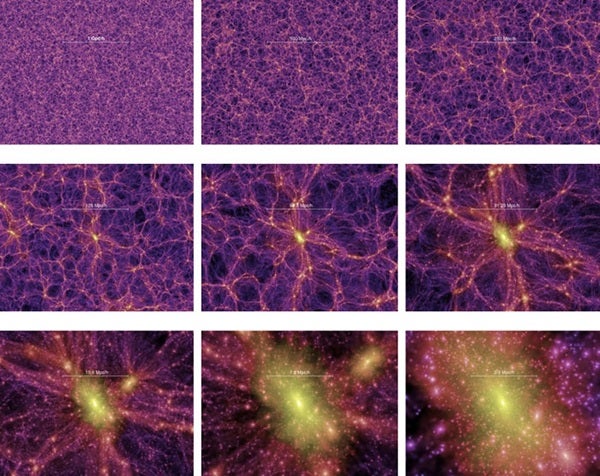An international group of astrophysicists known as the Virgo Consortium has created the largest and most realistic model to date of cosmic evolution. The consortium — a collaboration between German, British, Canadian, and U.S. astrophysicists and led by scientists from the Max-Planck-Institute for Astrophysics — simulated the growth of structure in a representative cube of the universe roughly 2 billion light-years on each side.
Because of the simulation’s size — dubbed the Millennium Simulation — the astrophysicists were able to observe evolutionary links between objects. Among the group’s findings are a possible explanation for early quasar formation, and another correlation between the sound waves from the cosmic microwave background (CMB) and the universe’s present structure.
The number of particles needed for the simulation is staggering: Roughly 10 billion particles were included to analyze the positions, velocities, and intrinsic properties of 20 million galaxies. The Millennium Simulation follows structure evolution from when the universe was 10 million years old (z=127) to the present day — and produced 20 terabytes of data.
The astrophysicists used the widely accepted initial conditions observed by both the Sloan Digital Sky Survey (SDSS) and the Wilkinson Microwave Anisotropy Probe (WMAP): The universe is composed of 4.5 percent ordinary, or baryonic, matter; 20.5 percent cold dark matter (CDM); and 75 percent dark energy.
SDSS has observed a number of high-redshift (z=6) galaxies with extremely active central supermassive black holes; these objects are called quasars. The discovery of these quasars — from roughly 900 million years after the Big Bang — has raised questions about the order of cosmic structure evolution. How could such huge objects — the central black holes are on the order of a billion solar masses each — have formed so early when the CDM model predicts only small structures should exist?
The Millennium Simulation shows “that objects as extreme as the bright z=6.2 Sloan quasars can indeed form in a λCDM [dark energy and CDM-dominated] universe at such an early time,” Volker Springel, lead author of the Virgo Consortium’s June 2, 2005, Nature paper, tells Astronomy. This finding gives further support for the CDM model of the universe by showing that there could be massive galaxies in the early universe. Also, by following the evolution of these quasars, the Millennium Simulation shows “the supermassive black holes that powered these first quasars should sit at the centers of [type] cD galaxies in rich clusters of galaxies today,” says Springel.
The consortium also found that while the acoustic oscillations from the CMB are distorted over time, their signature can still be detected in cosmic structures today.
What began as small density fluctuations, or wiggles, in the CMB grew into today’s cosmic structure. Gravitational collapse around these fluctuations was non-linear, which can be analyzed only through computer simulations. “Non-linear gravitational structure formation tends to progressively wash out these wiggles over time, starting at the higher order peaks [small spatial scales] and then working its way up to lower order peaks [large spatial scales],” says Springel. “Our simulation has shown that at the present day, even though the first order peak begins to be mildly affected, at least the first two peaks are still well enough in place to be distinguishable as a feature.”
By combining and tracking different computation models — dark-matter structures, star-forming regions, black-hole growth — the Virgo Consortium has simulated a universe that closely matches the observable universe. There is certainly more to be seen in the Millennium Simulation.










